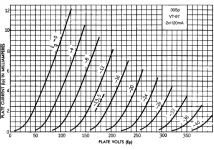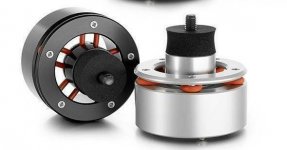Hello,
I got two pairs of NOS Hytron 30 and 30 Special DHT tubes and I'd like to fire them up and give them a good use in a line preamp (maybe followed by a 6SN7 CF,perhaps?)...but I found zero schematics.
Ideas,hints - anyone?
Every advice welcomed! 🙂
TIA
I got two pairs of NOS Hytron 30 and 30 Special DHT tubes and I'd like to fire them up and give them a good use in a line preamp (maybe followed by a 6SN7 CF,perhaps?)...but I found zero schematics.
Ideas,hints - anyone?
Every advice welcomed! 🙂
TIA
Last edited:
Not surprised aka- VR105/OC3 voltage regulators for tube RADIOS .
Used to stabilize Frequency Changer/Oscillator tube voltages in (mainly ) tube communications receivers, even then in the 50,s they were superseded by B7G varieties .
Their purpose was to cut down frequency drift due to component thermal changes over time as well as supply voltage changes .
I will let somebody else advise you on fitting them to a preamp as I am not ( personally ) in favor of it.
Used to stabilize Frequency Changer/Oscillator tube voltages in (mainly ) tube communications receivers, even then in the 50,s they were superseded by B7G varieties .
Their purpose was to cut down frequency drift due to component thermal changes over time as well as supply voltage changes .
I will let somebody else advise you on fitting them to a preamp as I am not ( personally ) in favor of it.
@duncan2:
Why so circumspect about using them as a line stage?Are the 30/30 Specials too "flimsy" tubes?
Why so circumspect about using them as a line stage?Are the 30/30 Specials too "flimsy" tubes?
Glow discharge voltage regulator tubes use a calculated process therefore a certain amount of electrical NOISE is introduced into the regulator voltage as the level of ionization varies .
Your decision is in the instance of a preamp with low to very low noise figures from BJT,s will a tube regulator add to that overall noise figure .
I am not saying you cant do it all I am saying is at the end of the day will it "improve " your noise figure ?
Watch out adding a small capacitor to try to reduce this as it could cause pulsing.
I don't think so but maybe somebody on DIY Audio thinks differently --if so I would like to see the calculations not just a-- yes it does reduce the overall noise figure .
Your decision is in the instance of a preamp with low to very low noise figures from BJT,s will a tube regulator add to that overall noise figure .
I am not saying you cant do it all I am saying is at the end of the day will it "improve " your noise figure ?
Watch out adding a small capacitor to try to reduce this as it could cause pulsing.
I don't think so but maybe somebody on DIY Audio thinks differently --if so I would like to see the calculations not just a-- yes it does reduce the overall noise figure .
Surely the Hytron 30 is a UX4 based low mu triode not a discharge valve?
2v filament @ .05A (and make an excellent pre/driver)
2v filament @ .05A (and make an excellent pre/driver)
It is a direct heated battery tube with 2Vdc 60mA filament. You can run one from a 2V lead cell for instance. Or build a CCS with high impedance @60mA per valve. Or buy some commercial boards. Standing current is just 3mA so do not expect much drive from this type without a buffer.
Attachments
I've used both 30 and 30sp in preamps. Sound is similar - the 30sp maybe a little beefier sounding. It's quite a neutral DHT, something like a 2P29L. Not warm like a 26 and not sparkling like a 01A. I thought the high frequency response was a bit flat sounding, coming from the 01A. But it's an "average to good" DHT.
The big difference is microphonics. The 30 definitely needs some sort of treatment to avoid microphonics, either airborne or chassis induced. The 30sp is much better in this regard and I didn't have much trouble with it.
Digging up my old data, it seems I was using it in filament bias, which would be a good way to do it. I used Rod Coleman filament regs. I also used a plate choke. I believe the data for 30 and 30sp are the same - couldn't find anything on VT-67 in Franks. Curves here.
The big difference is microphonics. The 30 definitely needs some sort of treatment to avoid microphonics, either airborne or chassis induced. The 30sp is much better in this regard and I didn't have much trouble with it.
Digging up my old data, it seems I was using it in filament bias, which would be a good way to do it. I used Rod Coleman filament regs. I also used a plate choke. I believe the data for 30 and 30sp are the same - couldn't find anything on VT-67 in Franks. Curves here.
Attachments
In these roles I would also recommend the VT-45, but please dont tell everyone!
Never came across it before! Useful looking tube. Seems rare and not cheap either, so I'm not going to jump on it. I'm pretty happy with 01A. Thanks for the info. I would have thought you're pretty safe there if you're collecting them.
Gents,
Thank you for chiming in.
@duncan2:I must confess that your second reply browned my underwear 😉 .Obviously,you thought thet the 30/30 Special are VRs,wich are not (and nafunga nailed it).
@painted:less drive is exactly why I opted for this tube(s) because I really don't need much of it - just a pinch! 😀
@andyjevans:the microphonics thing - taken to knowledge,thanks for the info.Something else:do you think that the sonical difference between the 30 and 30 SP lies in that the 30SP has a bigger heater current wich eventually means a larger electron emission?
Thank you for chiming in.
@duncan2:I must confess that your second reply browned my underwear 😉 .Obviously,you thought thet the 30/30 Special are VRs,wich are not (and nafunga nailed it).
@painted:less drive is exactly why I opted for this tube(s) because I really don't need much of it - just a pinch! 😀
@andyjevans:the microphonics thing - taken to knowledge,thanks for the info.Something else:do you think that the sonical difference between the 30 and 30 SP lies in that the 30SP has a bigger heater current wich eventually means a larger electron emission?
Last edited:
Hello,
I got two pairs of NOS Hytron 30 and 30 Special DHT tubes and I'd like to fire them up and give them a good use in a line preamp (maybe followed by a 6SN7 CF,perhaps?)...but I found zero schematics.
Ideas,hints - anyone?
Every advice welcomed! 🙂
TIA
The SE stage + 6SN7 follower is a very good idea. That's pretty straightforward.
As others already suggested, the most important things with battery tube are DC filament supply and isolation from vibrations.
Vibration isolation is less trivial than just damping with rings and solves the problem while damping doesn't....
The simplest isolation down to subsonic range around 5-10 Hz is something like the turntable feet in the picture below. The orange elastic wire is the only way the tube is mechanically connected to the chassis. The tube socket would be in the middle with a something heavy (lead block glued with epoxy for example) attached below to create the right load for the elastic such that the self-resonance is shifted as low as possible. Usually 4-5 Hz is possible without many problems.
Of course this simple system cannot compete with more refined solutions like air-springs and will have some damping (i.e. more than necessary) but the principle stands.
The principle is that true isolation does not allow vibrations to take place by dissipating the energy with imperceptible (moderately damped) oscillation at the self-resonance of the system under consideration (in this case the tube with its load below). At higher frequency it will behave like a 2nd order filter. With the simple system described at 20Hz attenuation can already be in 20 dB range (air-springs can get to 30+ dB) and continue to increase by 12 dB each time frequency doubles. Considering that self resonances of tubes are typically well above 100 Hz this simple system will be quite effective.
By definition damping is NOT isolation because damping happens when vibrations have already taken place and "damaged" the music signal.....
With true isolation tubes like 30 are in another league thanks to their very good linearity.
Attachments
Quite pricey £50.00 a pop at Langrex, not as bad as an 801a.Never came across it before! ...
50 GBP would be a good price for a real NOS 45. I have some doubt. Maybe is 50 +VAT? 50 GBP are 67 USD at the moment. Typical price from US is 85 USD at least...
- Home
- Amplifiers
- Tubes / Valves
- 30 and/or 30 Special line preamp ideas?


